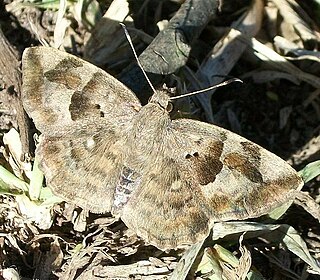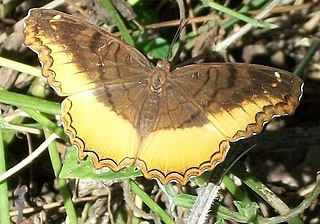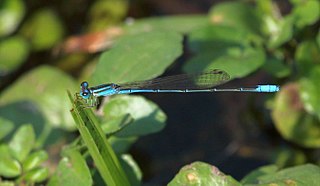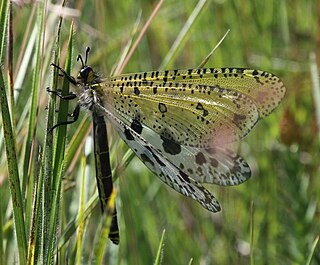
Cape Town is the second-most populous city in South Africa, after Johannesburg, and also the legislative capital of South Africa.

The African penguin, also known as the Cape penguin or South African penguin, is a species of penguin confined to southern African waters. Like all extant penguins, it is flightless, with a streamlined body and wings stiffened and flattened into flippers for a marine habitat. Adults weigh an average of 2.2–3.5 kg (4.9–7.7 lb) and are 60–70 cm (24–28 in) tall. The species has distinctive pink patches of skin above the eyes and a black facial mask. The body upperparts are black and sharply delineated from the white underparts, which are spotted and marked with a black band. The pink glands above their eyes help them with thermoregulation. To cope with changing temperatures, blood is sent to the glands to be cooled by the air.

The antlions are a group of about 2,000 species of insect in the family Myrmeleontidae, known for the fiercely predatory habits of their larvae, which in many species dig pits to trap passing ants or other prey. The adult insects are less well known, due to their relatively short lifespans compared to the larvae. Adults mostly fly at dusk or after dark, and may be mistakenly identified as dragonflies or damselflies; they are sometimes known as antlion lacewings. In North America, the larvae are sometimes referred to as doodlebugs because of the strange marks they leave in the sand.

The Cape weaver is a species of bird in the weaver family, Ploceidae, found in southern Africa.

The Cape robin-chat is a small passerine bird of the Old World flycatcher family Muscicapidae. It has a disjunct range from South Sudan to South Africa. The locally familiar and confiding species has colonized and benefited from a range of man-altered habitats, including city suburbs and farmstead woodlots. It is an accomplished songster like other robin-chats, but is rather less colourful than most, and frequents either dryer settings or higher altitudes. It forages in the proximity of cover, in the open or in fairly well-lit environments. Its distribution resembles that of the karoo–olive complex of thrushes, but it prefers the bracken-briar fringes of Afromontane forest, and does not enter far into forest proper. It is altitudinally segregated from the red-capped robin-chat, and is less of a skulker.

Acraea acara, commonly known as the acara acraea, is a butterfly of the family Nymphalidae which is native to East and southern Africa.

The Harry Oppenheimer Fellowship Award is awarded annually by the Oppenheimer Memorial Trust. It is considered the top award for research on the African continent.

Deinbollia oblongifolia is a shrub or small tree in the family Sapindaceae. It is commonly known as the dune soap-berry and is found in coastal vegetation from the Eastern Cape of South Africa, through KwaZulu-Natal to southern Mozambique and Swaziland. It is named after Peter Vogelius Deinboll (1783-1876), a Danish botanist and plant collector.

Sarangesa motozi, the forest elfin or elfin skipper, is a butterfly of the family Hesperiidae, and native to southern and eastern Africa.

Dixeia pigea, the ant-heap small white or ant-heap white, is a butterfly in the family Pieridae that is native to Africa.

Eurytela dryope, the golden piper, is a butterfly of the family Nymphalidae, found in Sub-Saharan Africa, the Arabian peninsula and Madagascar.
The Southern African Bird Atlas Project (SABAP) was conducted between 1987 and 1991. Because a new bird atlas was started in southern Africa in 2007, the earlier project is now referred to as SABAP1. The new atlas project is known as the Second Southern African Bird Atlas Project, and is abbreviated to SABAP2. SABAP2 is still ongoing. It is now managed by the FitzPatrick Institute of African Ornithology at the University of Cape Town. Most of the data capture happens through the application BirdLasser. The project is currently funded by BirdLife South Africa and the South African National Biodiversity Institute.
The Animal Demography Unit (ADU) is a formally recognized research unit of the University of Cape Town (UCT) located within the Department of Biological Sciences of UCT.. The Animal Demography Unit, popularly known as the ADU, was responsible for the management of the First and Second Southern African Bird Atlas Projects SABAP1 and SABAP2. The unit has submitted over eight million georeferenced biodiversity records to GBIF.

Empisini Nature Reserve was established in 1973 and is situated in Umkomaas, KwaZulu-Natal, South Africa. The reserve is approximately 60 ha in extent and is owned by the borough of uMkhomanzi which has been incorporated into the eThekwini municipality. Empisini is managed jointly by eThekwini and the Umkomaas centre of the Wildlife and Environment Society of South Africa. Empisini takes its name from a perennial stream which flows through it, and means "Place of the Hyena" in isiZulu. The reserve consists of coastal forest, wetlands, grassy slopes and a dam. Infrastructure consists of hiking trails, demarcated picnic sites, overnight cabins, and a tree house.

Africallagma fractum, the slender bluet, is a species of damselfly in the family Coenagrionidae. It has been found in Angola, southern Democratic Republic of the Congo, Zambia, Malawi, Mozambique, Zimbabwe, and eastern South Africa.
The South African Bird Ringing Unit (SAFRING) is based at the University of Cape Town and provides bird ringing services in South Africa and other African countries. This entails providing ringing equipment to qualified ringers, and curating all ringing data. SAFRING communicates with ringers and interested parties through annually publishing one or two issues of a newsletter, Afring News, and by maintaining a list server. SAFRING holds national training courses, annually if there is sufficient demand. SAFRING liaises with the provinces who have the responsibility of issuing permits. SAFRING has a strict code of ethics to ensure the safety of birds handled. SAFRING acknowledges the importance of bird ringing in that it has been described as the most important tool in ornithology in the 20th century.

Neuroleon is a large and complex genus of antlions in the subfamily Myrmeleontinae. There are more than 150 described species from Europe, Asia and Africa, and there are many undescribed taxa. Where the biology of the larvae is known, they live freely in sand or in sheltered rock crevices.

Palpares caffer is a species of antlions in the family Myrmeleontidae, which is native to southern Africa. It was described by Hermann Burmeister in 1839.

Centroclisis is a genus of antlions (Myrmeleontidae) with about 56 species occurring in Africa and Asia. They are known as bark antlions - during the day they rest on the bark of trees, with their wings flattened. At night they may be attracted to lights.

SeaKeys is a large collaborative marine biodiversity project funded through the Foundational Biodiversity Information Program in South Africa. The purpose of the project is to collect and distribute genetic, species and ecosystem information relating to marine biodiversity in southern Africa, which may be used to support informed decision-making about the marine environment.






















